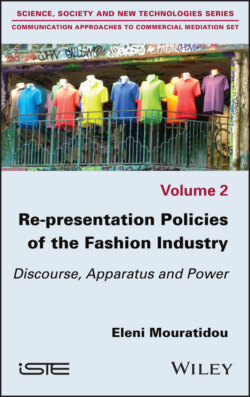Читать книгу Re-presentation Policies of the Fashion Industry - Eleni Mouratidou - Страница 17
I.8.1. The semio approach
ОглавлениеSemiotic and discursive analysis is used to observe and question the communicational hybridizations resulting from the strategies analyzed, the rewriting processes to which these strategies bear witness, and the shaping of discourse – in the semiotic sense of the term – allowing us to grasp the re-presentational policies implemented by advertisers in this industry. In an effort to circumscribe the theoretical framework within which this analytical approach is thought of and applied, the aim now is to evoke a semio approach that brings together different theoretical currents.
As much an analysis as a position to be adopted, the semio approach is conceived of through semiotics, semio-pragmatics, semiology and discourse analysis mobilized according to the communicational practice observed and the analytical relevance that accompanies it. In other words, it is a matter of opting for one or another theoretical and methodological framework depending on the objects, the latter being endowed with a “semiotic overdose or [an] emphatic hold over the sign” (Boutaud and Berthelot-Guiet 2013, author’s translation), or even on the discourses. The semiotic point of view that marks current research is defined as the outline of the axiological and symbolic system of commercial mediations as deployed by the fashion industry’s re-presentation policies. It is not a method in its own right, but an approach that consists of bringing together, around a single object of study, different theoretical and methodological frameworks that make it possible to question the staging of the communicative processes under analysis and to grasp the “productive tension between semiotics and communication” (Boutaud and Eliseo-Veron 2007, p. 25, author’s translation).
Greimassian semiotics and the semiotics of the Belgian school of thought are called upon to account for the visual dimension of certain re-presentational policies such as advertising campaigns or ready-to-wear collections (Floch 1985, 1990; Groupe µ 1992; Klinkenberg 1996a; Beyaert-Geslin 2009; Dondero 2009), their genres, their statutes, their formats (Basso Fossali and Dondero 2011) and their enunciative strategies (Fontanille 2003, 2015). The relevance of this approach consists of highlighting the visual and generic transformations that are taking place, but also the enunciative hybridizations of the actors who are the ones enacting these practices.
The semio-pragmatic analysis (Odin 2011) is called upon to question the reconfigurations of the communication spaces invested in by the fashion industry. Starting from the source spaces and their semio-pragmatic functioning, this method makes it possible to focus on the pre-textual dimension of the source text and the way it is modified by the new text updated by the fashion industry.
Discourse analysis is included here in the general approach qualified as semio, on the one hand, insofar as it is mobilized as an analytical framework for discursive staging contributing to the fashion industry’s re-presentation policies, and, on the other hand, as soon as certain theoretical contributions of discourse analysis are adapted to the study of syncretic elements, bringing together verbal and non-verbal productions. It is from this perspective that I have recourse to Dominique Maingueneau’s work on the density that structures an “enunciation scene” (Maingueneau 1998b, pp. 55–71) and on the notion of “reinvestment” (Maingueneau 1991), and to Krieg-Planque’s (2009) work on the notion of “formula” and, as far as our research is concerned, on its extension into non-verbal utterances (Mouratidou 2018a).
In an interdisciplinary way, this analytical position is covered by Roland Barthes’ semiological project, not so much from the point of view of the method as from the point of view of its aim, the search for meaning, making it possible to construct an ideological critical praxis (1985). The various analytical frameworks called upon throughout this research will make it possible to grasp the life of the signs emitted by the fashion industry within social life (Saussure 1916, p. 33), to account for their political influence and the way in which they contribute to the transformation of social life. While the critical dimension is not a position adopted a priori, it is because this research is not conceived of as aiming to criticize the luxury fashion industry’s capitalist system. However, it can take place through the questioning of the “semantic and symbolic system of our civilisation” (Barthes 1985, p. 14), in which the fashion industry participates and gives an account of the societal powers and political stakes that permeate our civilization. As Jeanneret (2007, p. 111) reminds us, “when we read Barthes’ inaugural lecture at the Collège de France, given in February 1977 [...], we cannot help but be struck by the fact that semiology remains, as in the age of Mythologies, a political work aimed at defining the circulation of power. It is not for nothing that Michel Foucault recommended Barthes’ election” (author’s translation).
